Radio observations of Kosmos-186/188 -
the first automatic docking
Sven Grahn
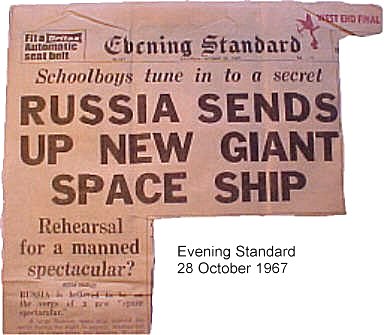 Friday
27 October 1967
Friday
27 October 1967
Saturday
28 October 1967
Sunday
29 October 1967
Monday
30 October 1967
Tuesday
31 October 1967
References
Friday
27 October 1967
At 0930 UT, Kosmos-186,
an unmanned 7K-OK Soyuz ship, was launched from Baikonur to work
as the active ship in the attempt to achieve an automatic rendezvous
and
possibly docking with another, similar, ship to be launched two days
later.
TASS did announce the flight but news media in the West confused the
reporting
considerably because Kosmos-185 was launched the same day and
Kosmos-187,
a FOBS flight, was launched the following day.
The Kettering
Grammar School was listening on 20.008 MHz on thisday and
picked
up what was later found out to be typical Soyuz telemetry at 1630-1645
UT (1). Here is science master Geoff
Perry's account of what happened:
"......It rained on
the
morning of the Friday of the 1967 autumn half-term holiday. It started
when I was on the fourth tee of Corby's municipal golf course and I got
soaked to the skin. I went to the Labs in the afternoon and switched on
the CR-100. It was not long before I heard a short burst of irregular
pulses.
I ran the tape recorder and recorded further 30-second bursts at two
minute
intervals. In 1966 Ken Edwards had sent a pen record of some strange
signals
for me to identify. They, too, consisted of 30-second
bursts of irregular pulses at two minute intervals and proved to have
been
from Kosmos-140, a precursor of the ill-fated Soyuz-1. My
signals
were from the first test of a Soyuz since Komarov's tragic death (see "Analysis
of the Soyuz-1 flight"). ......"
(The signals
transmitted
by Kosmos-140 and subsequent Soyuz-type flights were CW-PDM
signals).
Saturday
28 October 1967
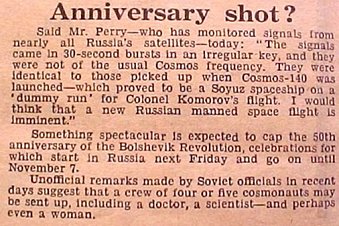 On
the Saturday day Geoff Perry mentioned, in passing, to the journalist
Peter
Fairley that a Soyuz test flight was under way and he blazed the news
across
the front page of the London Evening Standard (see picture above right
and a quote from the article on the right). In Sweden the television
news
at 1800 UT mentioned that one of the spacecraft launched on 27 th was
in
an orbit similar to that of Soyuz. This really alerted me to the fact
that
one of the Kosmos satellites launched on the 27 th was something
special
that I should pay attention to. At Kettering it was observed that, from
revolution 20, the signals on 20.008 MHz became continuous instead of
transmitted
in 30-second burst .
On
the Saturday day Geoff Perry mentioned, in passing, to the journalist
Peter
Fairley that a Soyuz test flight was under way and he blazed the news
across
the front page of the London Evening Standard (see picture above right
and a quote from the article on the right). In Sweden the television
news
at 1800 UT mentioned that one of the spacecraft launched on 27 th was
in
an orbit similar to that of Soyuz. This really alerted me to the fact
that
one of the Kosmos satellites launched on the 27 th was something
special
that I should pay attention to. At Kettering it was observed that, from
revolution 20, the signals on 20.008 MHz became continuous instead of
transmitted
in 30-second burst .
It seems that an
attempt
to raise the orbit of Kosmos-186 was made on the "17 th revolution",
but
had to be postponed to the following day because of problems with an
attitude
sensor (2). This probably delayed the
launch
of the passive ship until 30 October.
Sunday
29 October 1967
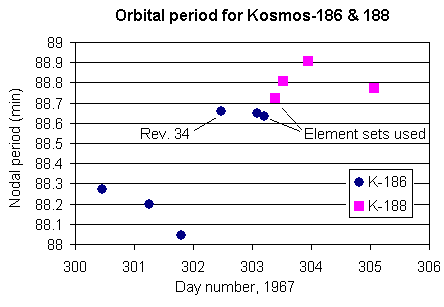 Signals
on 20.008 MHz were received at Kettering on rev 33 and throughout rev
34
until 1147 UT. After that Kosmos-186 went silent. Therefore, Geoff
Perry
thought it was possible that the the spacecraft had been recovered. The
morning news broadcast on Radio Sweden quoted Sir Bernard Lovell of the
Jodrell Bank radio observatory as saying that something big was
underway.
Morning papers in Sweden mentioned the fact that Kettering Grammar
School
had picked up signals similar to those from Kosmos-140. As for myself I
kept searching for Kosmos-186 but adopted a rather unfortunate tracking
strategy by listening to 19.995 MHz for two hours and then 20.008 MHz
for
two hours. I kept doing so until 1200 UT and therefore probably missed
the transmissions from Kosmos-186.
Signals
on 20.008 MHz were received at Kettering on rev 33 and throughout rev
34
until 1147 UT. After that Kosmos-186 went silent. Therefore, Geoff
Perry
thought it was possible that the the spacecraft had been recovered. The
morning news broadcast on Radio Sweden quoted Sir Bernard Lovell of the
Jodrell Bank radio observatory as saying that something big was
underway.
Morning papers in Sweden mentioned the fact that Kettering Grammar
School
had picked up signals similar to those from Kosmos-140. As for myself I
kept searching for Kosmos-186 but adopted a rather unfortunate tracking
strategy by listening to 19.995 MHz for two hours and then 20.008 MHz
for
two hours. I kept doing so until 1200 UT and therefore probably missed
the transmissions from Kosmos-186.
At 1320 UT I made a
telephone
call to Kettering . Geoff Perry gave me the orbital data that I needed
and also the bad news that the craft was possibly down.
The raising of the
orbit
planned for the previous day was rescheduled for the "31 st revolution"
(2),
but again had to be put off because the proper commands had not been
uploaded.
Western tracking data show that the orbit had indeed been raised by
rev.
34.
Monday
30 October 1967
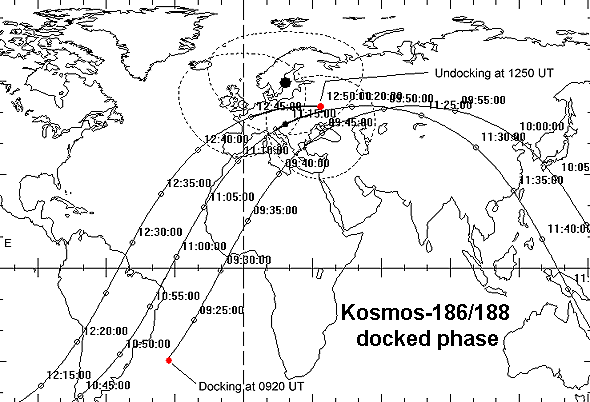 I
did not have any lectures or laboratory work at the Royal Institute of
Technology this particular morning, so I spent the morning hours trying
to find signals from Kosmos-186 starting at 0730 UT. At 0817 UT the
signal
on 20.008 MHz was commanded on but was quite weak and faded out at 0824
UT. But there was no doubt, this was the typical Soyuz telemetry.
I
did not have any lectures or laboratory work at the Royal Institute of
Technology this particular morning, so I spent the morning hours trying
to find signals from Kosmos-186 starting at 0730 UT. At 0817 UT the
signal
on 20.008 MHz was commanded on but was quite weak and faded out at 0824
UT. But there was no doubt, this was the typical Soyuz telemetry.
So, Kosmos-186 was
still
in orbit or another craft had been launched. I ordered a call
to
Kettering at 0914, but this being a working day, the operator told me
it
would take another hour to get through (this was in the days before
direct
dialing and international calls had to be ordered through the
operator)!
While waiting for the call to come through Kosmos-186 came around again
and I heard strong signals at 0935.50-0958.40 UT. Still
more
signals, but weak at 1112.05-1118 UT. I talked to Kettering again at
1215
UT (after having waited for the call 80 minutes) and Geoff Perry seemed
to think that there was another ship in orbit.
I felt that something
unusual
was going on, especially after having received a short burst of
extremely
strong CW-PDM signals on 20.008 MHz being commanded on at 1248.45 UT
and
switched off at 1251.45 UT. The signals were again commanded on at
1253.22
UT and faded out at 1331 UT. The last set of signals received by me on
the Monday was picked up on 20.008 MHz from 1409.05 until 1422.27 UT
when
they were commanded off (listen
here).
(A map of my receptions on 20.008 MHz on 30 Oct 1967 is shown here)
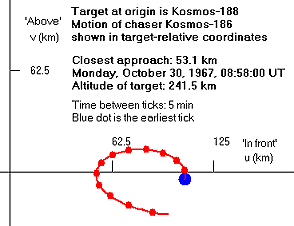 What
had indeed happened was that Kosmos-188 had been launched from Baikonur
at 0812 UT to serve as the passive target of Kosmos-186. As the new
spacecraft
passed the Ussuriysk ground station in Russia's far east commands were
uplinked to the two craft to attempt a docking during the first
revolution
of Kosmos-188. It seems that the decision to actually perform the
docking
and not just a close approach - as the flight plan stated - was taken
just
before the launch of Kosmos-188 (2).
What
had indeed happened was that Kosmos-188 had been launched from Baikonur
at 0812 UT to serve as the passive target of Kosmos-186. As the new
spacecraft
passed the Ussuriysk ground station in Russia's far east commands were
uplinked to the two craft to attempt a docking during the first
revolution
of Kosmos-188. It seems that the decision to actually perform the
docking
and not just a close approach - as the flight plan stated - was taken
just
before the launch of Kosmos-188 (2).
According to Russian
sources
Kosmos-188 was 24 km from Kosmos-186 at orbital insertion and the IGLA
system for automatic approach and docking was activated. I have
tried to verify this Russian claim by using Western orbital data. The
Kosmos-186
element set closest to the launch of Kosmos-188 is the one valid for at
05:04:25 UT on 30 October. The orbital data for Kosmos-188, the passive
ship, at 09:30:33 UT represents the orbit 10 minutes after docking. By
using these element sets the graph on the right can be generated. It
shows
the motion of Kosmos-188 relative to Kosmos-186 from orbital insertion
of Kosmos-188 until the moment of docking. From this figure it seems
that
Kosmos-186 was placed approximately 100 km in front of Kosmos-188.
However,
the element sets of newly launched objects are often inaccurate, so the
Russian claim can very well be absolutely correct.
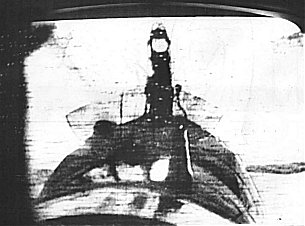 The
docking took place at 0920 UT beyond the reach of tracking stations on
Soviet soil off the coast of South America. Mission control at
Yevpatoria
was able to ascertain that the docking had taken place by monitoring
short-wave
telemetry (2) - presumably the 20.008
MHz
link - some 15 minutes before the craft appeared over the horizon of
Yevpatoria
(which occurred at 0940 UT). As can be determined above I received the
short-wave telemetry at 0935.50, about 15 minutes after the docking.
The
docking took place at 0920 UT beyond the reach of tracking stations on
Soviet soil off the coast of South America. Mission control at
Yevpatoria
was able to ascertain that the docking had taken place by monitoring
short-wave
telemetry (2) - presumably the 20.008
MHz
link - some 15 minutes before the craft appeared over the horizon of
Yevpatoria
(which occurred at 0940 UT). As can be determined above I received the
short-wave telemetry at 0935.50, about 15 minutes after the docking.
When the two craft
appeared
over the horizon at Yevpatoria television images showed the craft to be
docked (see picture on the right), but telemetry revealed that its was
only a "soft dock" with a gap of 85 mm between the vehicles (2).
Undocking occurred well within view of Yevpatoria at 1250 UT, in the
middle
of the transmission picked up by myself at 1248.45-1251.45 UT.
Controllers
at Yevpatoria could see the craft separate via a live TV transmission
from
the craft.
Tuesday
31 October 1967
I picked up signals on
20.008
MHz at 0630.25-0638.30 UT, but this was not the recovery orbit and it
is
not even certain that they came from Kosmos-186. At 0740-0800 UT
signals
on the same frequency were picked up at Kettering, but these could not
have come from Kosmos-186 because the retrofire for that spacecraft
occurred
at 0738 UT and the touchdown at 0812 UT (0820 UT), so these signals
must
have come from Kosmos-188. No more signals on shortwaves were heard
during
the day. I "dropped track" at 1700 UT. However, later in the evening
the
Bochum space observatory picked up Kosmos-188, and a radio amateur
friend
of mine heard further signals on 20.008 MHz in 30-sec bursts at
1910-1935
UT. Nothing further was heard from Kosmos-188, even though I tried very
hard during 1 November to make further receptions.
Thursday
2 November 1967
It was decided to de-orbit
Kosmos-188
on 2 November (2). This craft also had
problems with its attitude sensors and had to rely on the ion flow
sensors
for pitch and yaw control. However, when retrofire occurred at
0703
UT, the craft entered an area with lower ion density and the attitude
during
the braking maneuver was inaccurate. Therefore, the re-entry trajectory
was too shallow and the craft would have come down some 300-400 km
beyond
Ulan-Ude - 3500 km from the intended landing spot. However, the
self-destruct
system blew up the re-entry vehicle as it flew over Irkutsk. The
self-destruct
system worked on the principle that re-entry g-forces had to occur at a
certain time after the end of retrofire. The shallow re-entry
trajectory
caused the destruct criterion to be triggered. The map below shows the
landing path of Kosmos-188.
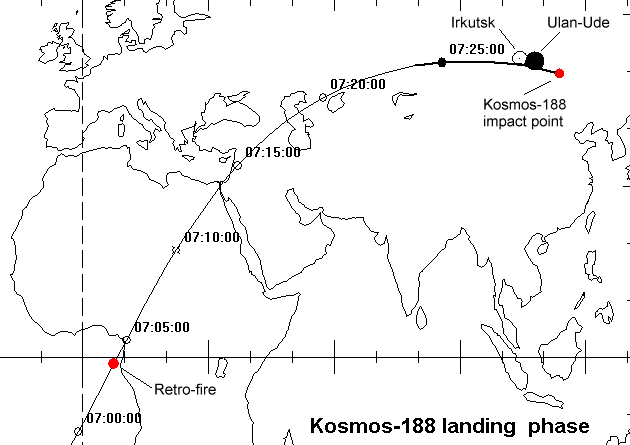
References
-
Perry,
Geoff, letter to Sven Grahn, dated 6 November 1967
-
Hendrickx,
Bart, "The Kamanin Diaries 1967-68", JBIS, Vol. 53, No 11/12,
Nov-Dec
2000, pp.398-400

 Back
to Space Tracking Notes
Back
to Space Tracking Notes
 What
had indeed happened was that Kosmos-188 had been launched from Baikonur
at 0812 UT to serve as the passive target of Kosmos-186. As the new
spacecraft
passed the Ussuriysk ground station in Russia's far east commands were
uplinked to the two craft to attempt a docking during the first
revolution
of Kosmos-188. It seems that the decision to actually perform the
docking
and not just a close approach - as the flight plan stated - was taken
just
before the launch of Kosmos-188 (2).
What
had indeed happened was that Kosmos-188 had been launched from Baikonur
at 0812 UT to serve as the passive target of Kosmos-186. As the new
spacecraft
passed the Ussuriysk ground station in Russia's far east commands were
uplinked to the two craft to attempt a docking during the first
revolution
of Kosmos-188. It seems that the decision to actually perform the
docking
and not just a close approach - as the flight plan stated - was taken
just
before the launch of Kosmos-188 (2).
 Friday
27 October 1967
Friday
27 October 1967
 On
the Saturday day Geoff Perry mentioned, in passing, to the journalist
Peter
Fairley that a Soyuz test flight was under way and he blazed the news
across
the front page of the London Evening Standard (see picture above right
and a quote from the article on the right). In Sweden the television
news
at 1800 UT mentioned that one of the spacecraft launched on 27 th was
in
an orbit similar to that of Soyuz. This really alerted me to the fact
that
one of the Kosmos satellites launched on the 27 th was something
special
that I should pay attention to. At Kettering it was observed that, from
revolution 20, the signals on 20.008 MHz became continuous instead of
transmitted
in 30-second burst .
On
the Saturday day Geoff Perry mentioned, in passing, to the journalist
Peter
Fairley that a Soyuz test flight was under way and he blazed the news
across
the front page of the London Evening Standard (see picture above right
and a quote from the article on the right). In Sweden the television
news
at 1800 UT mentioned that one of the spacecraft launched on 27 th was
in
an orbit similar to that of Soyuz. This really alerted me to the fact
that
one of the Kosmos satellites launched on the 27 th was something
special
that I should pay attention to. At Kettering it was observed that, from
revolution 20, the signals on 20.008 MHz became continuous instead of
transmitted
in 30-second burst .
 Signals
on 20.008 MHz were received at Kettering on rev 33 and throughout rev
34
until 1147 UT. After that Kosmos-186 went silent. Therefore, Geoff
Perry
thought it was possible that the the spacecraft had been recovered. The
morning news broadcast on Radio Sweden quoted Sir Bernard Lovell of the
Jodrell Bank radio observatory as saying that something big was
underway.
Morning papers in Sweden mentioned the fact that Kettering Grammar
School
had picked up signals similar to those from Kosmos-140. As for myself I
kept searching for Kosmos-186 but adopted a rather unfortunate tracking
strategy by listening to 19.995 MHz for two hours and then 20.008 MHz
for
two hours. I kept doing so until 1200 UT and therefore probably missed
the transmissions from Kosmos-186.
Signals
on 20.008 MHz were received at Kettering on rev 33 and throughout rev
34
until 1147 UT. After that Kosmos-186 went silent. Therefore, Geoff
Perry
thought it was possible that the the spacecraft had been recovered. The
morning news broadcast on Radio Sweden quoted Sir Bernard Lovell of the
Jodrell Bank radio observatory as saying that something big was
underway.
Morning papers in Sweden mentioned the fact that Kettering Grammar
School
had picked up signals similar to those from Kosmos-140. As for myself I
kept searching for Kosmos-186 but adopted a rather unfortunate tracking
strategy by listening to 19.995 MHz for two hours and then 20.008 MHz
for
two hours. I kept doing so until 1200 UT and therefore probably missed
the transmissions from Kosmos-186.
 I
did not have any lectures or laboratory work at the Royal Institute of
Technology this particular morning, so I spent the morning hours trying
to find signals from Kosmos-186 starting at 0730 UT. At 0817 UT the
signal
on 20.008 MHz was commanded on but was quite weak and faded out at 0824
UT. But there was no doubt, this was the typical Soyuz telemetry.
I
did not have any lectures or laboratory work at the Royal Institute of
Technology this particular morning, so I spent the morning hours trying
to find signals from Kosmos-186 starting at 0730 UT. At 0817 UT the
signal
on 20.008 MHz was commanded on but was quite weak and faded out at 0824
UT. But there was no doubt, this was the typical Soyuz telemetry.
 The
docking took place at 0920 UT beyond the reach of tracking stations on
Soviet soil off the coast of South America. Mission control at
Yevpatoria
was able to ascertain that the docking had taken place by monitoring
short-wave
telemetry
The
docking took place at 0920 UT beyond the reach of tracking stations on
Soviet soil off the coast of South America. Mission control at
Yevpatoria
was able to ascertain that the docking had taken place by monitoring
short-wave
telemetry 